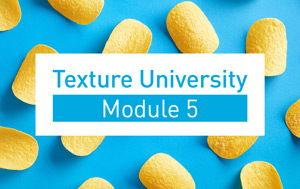Tate & Lyle’s educational webinar series for food formulators, Texture University, returns in January with insights into achieving the optimal texture in bakery, snacks and more.
Back for its second year, this quarterly broadcast, presented by scientists for scientists, continues its curriculum with module five, looking at how to formulate with film forming starch.
In the one-hour session, Research Scientist Mariana Perez Herrera, Ph.D. and Tate & Lyle’s Principal Scientist for Food & Beverage Solutions, Sanjiv Avashia, will take audiences through the science of:
- The physical properties behind film forming starch
- Developing the optimal crisp, crunchy texture across various snacks
- Improving dough formation in baked goods
- Understanding the role of viscosity, dispersion and stability in film forming starch selection
Our first four modules have seen active participation from attendees in every continent, from the largest food and beverage companies to the smallest start-ups. You can catch up on past Texture University modules here.
Over 99% of Texture University participants say they find the information useful*, so if you’re a food formulator struggling to get the best results with your product, look no further.
Registration is now open, sign up here to join us at 9am (Central Standard Time) on Wednesday 29 January 2020.
* based on a Tate & Lyle post-event survey
The complete curriculum
Learn about the following topics:
- How does the composition of starch impact its performance?
- What impact does processing have over starch produced from corn compared to one produced from tapioca?
- What challenges can starch be used to solve in food formulation?
Global webinar: Recap here
Asia-Pacific webinar: Recap here
There is such a variety of thickeners to choose from, it is often difficult to know the most appropriate one to use. In this module we answer:
- How does the level of viscosity influence the thickener?
- Which is the best thickener to formulate with, when a product demands a high level of process tolerance?
- What influence do thickener properties have on the sensory characteristics of food?
- How can a thickening starch help to optimise shelf stability in a frozen product?
Global webinar: Recap here
Asia-Pacific webinar: Recap here
Focusing on why instant starches are critical enablers in formulating everything from bakery fillings, sauces, snacks and confectionary. The module will also answer:
- How dispersibility affects starch performance?
- What variables affect the swelling rate of the starch?
- How do you minimise stickiness and dough machinability in snacks?
- What role do instant starches play in minimising bake out in pastry fillings?
Asia-Pacific: Recap here
Global webinar: Recap here
Widely used in formulations across confectionery, dairy, and dressings, each gelling starch has its own unique set of textural properties that impact formulation. This module will look at the science behind what makes:
- Firm, non-sticky, brittle, gelled texture in jelly candies
- Soft-gelled texture for spoonable dressings, yogurt, and other dairy products
- Fat-like texture in low fat spreads
- Firm, melt-able texture for processed cheese
Global webinar: Recap here
Asia-Pacific webinar: Coming soon!
Gain insights into achieving the optimal texture in convections, processed cheese, bakery and more, with module five from Texture University. This module will take audiences through:
- The physical properties behind film forming starch and dextrinisation
- Developing the optimal coating in confectionary and snacks
- Improving dough formation in batters and breading, baked goods and more
- Understanding the role of viscosity, dispersion and stability in film forming starch selection.
Global webinar: Recap here
Asia-Pacific webinar: Coming soon!
Find out how emulsifying starch can help replace:
- Gum arabic in beverage emulsions
- Egg yolks in dressings
- Caseinates in non-dairy creamers
Also learn how to avoid emulsion breakage during processing and to discern how emulsifying starch viscosity can be tailored to specific food processes.
Global webinar: Recap here
Asia-Pacific webinar: Coming soon
Discover at the root cause of starch instability and how to avoid issues like:
- Graininess in gravies and sauces after frozen storage
- Bakery filling weeping after refrigeration
- Separated yogurt with excess syneresis
Learn how your formulation can influence the stability of starch; as well as how to successfully overcome additional challenges that trends such as reduced sugar and clean label add to product development.
Discover the sensory science behind evaluating the stability in foods.
Global webinar: Recap here!
Different starches react in different ways during processing. Discover how to avoid common formulation issues such as:
- Low-viscosity in clean label dairy, soups and sauce formulations.
- Sinking fruits, vegetables and spices during processing of convenience-orientated soups and sauces.
- Boil-out and viscosity impact in reduced sugar pie and pastry fruit fillings.
Our latest module will dive deeper into starch applications, focussing on how choosing the right starch for processing delivers the texture, taste and mouthfeel that consumers enjoy, whilst also meeting demand for clean label and plant-based products.
Global webinar: Recap here
Today’s consumer wants to enjoy healthier foods without compromising on taste and texture. When meeting demand for healthier foods without compromising on taste and texture, reducing fat, water and oil, and determining the optimal starch usage, is key. Learn how to:
- How to use starch to build texture back into the low-fat soups, sauces, dressings and dairy products that are currently trending.
- How to choose the right starch for each formulation, based on your products’ fat, oil and water ratios.
- How to use the right amount of each starch. Armed with the right expertise, developing low fat, creamy and flavourful foods is easier than you think!
Global webinar: Recap here!
